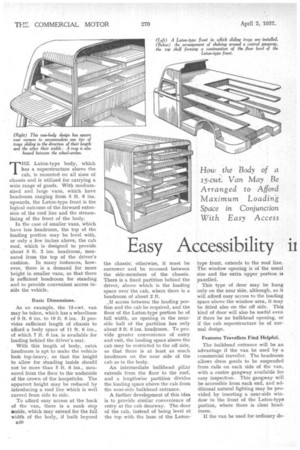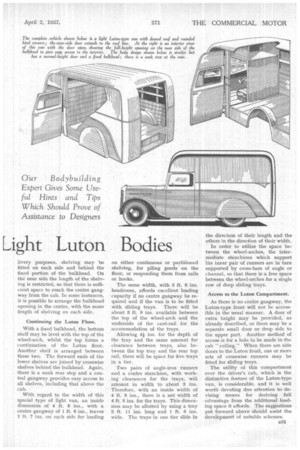Easy Accessibility Ii
Page 44

Page 45

If you've noticed an error in this article please click here to report it so we can fix it.
Light Luton Bodies
THE Luton-type body, which has a superstructure above the cab, is mounted on all sizes of chassis and is utilized for carrying a wide range of goods. With mediumsized and large vans, which have headroom ranging from 5 ft. 6 ins. upwards, the Luton-type front is the logical outcome of the forward extension of the roof line and the streamlining of the front of the body.
In the case of smaller vans, which have less headroom, the top of the loading portion may be level with, or only a few inches above, the cab roof, which is designed to provide about 3 ft. 2 ins, headroom, measured from the top of the driver's cushion. In many instances, however, there is a demand for more height in smaller vans, so that there is sufficient headroom for standing and to provide convenient access inside the vehicle.
Basic Dimensions.
As an example, the 15-cwt. van may be taken, which has a wheelbase of 9 ft. 6 ins. to 10 ft. 6 ins. It provides sufficient length of chassis to afford a body space of 1 1 ft. 6 ins., of which 7 ft. 6 ins, is available for loading behind the driver's seat.
With this length of body, extra headroom is apt to make the vehicle look top-heavy, so that the height to allow for. standing inside should not be more than 5 ft. 6 ins., measured from the floor to the underside of the crown of the hoopsticks. The apparent height may be reduced by introducing a roof line which is well curved from side to side.
To afford easy access at the back of the van, there is a sonic step inside, which may extend for the full width of the body, if built beyond n30 the chassis; otherwise, it must be narrower and be recessed between the side-members of the chassis. There is a fixed partition behind the driver, above which is the loading space over the cab, where there is a headroom of about 2 ft.
If access between the loading portion and the cab be required, and the floor of the Luton-type portion be of full width, an opening in the nearside half of the partition has only about 3 ft. 6 ins. headroom. To provide greater convenience of entry and exit, the loading space above the cab may be restricted to the off side, so that there is at least as much headroom on the near side of the cab as in the body.
An intermediate bulkhead pillar extends from the floor to the roof, and a lengthwise partition divides the loading space above the cab from the near-side bulkhead entrance.
A further development of this idea is to provide similar convenience of entry at the cab doorway. The door of the cab, instead of being level at the top with the base of the Luton type front, extends to the roof line. The window opening is of the usual size and the extra upper portion is panelled.
This type of door may be hung only on the near side, although, as it will afford easy access to the loading space above the window area, it may be fitted also on the off side. This kind of door will also be useful even if there be no bulkhead opening, or if the cab superstructure be of normal design.
Features Travellers Find Helpful.
The bulkhead entrance will be an advantage if the van be used by a commercial traveller. The headroom allows dress goods to be suspended from rails on each side of the van, with a centre gangway available for easy inspection. This gangway will be accessible from each end, and additional natural lighting may be provided by inserting a near-side window in the front of the Luton-type portion, where there is clear headroom.
If the van be used for ordinary de livery purposes, shelving may be fitted on each side and behind the fixed portion of the bulkhead. On the near side the length of the shelving is restricted, so that there is sufficient space to reach the centre gangway from the cab. In some instances, it is possible to arrange the bulkhead opening in the centre, with the same length of shelving on each side.
Continuing the Luton Floor.
With a fixed bulkhead, the bottom shelf may be level with the top of the wheel-arch, whilst the top forms a continuation of the Luton floor. Another shelf is arranged between these two. The forward ends of the lower shelves are joined by crosswise shelves behind the bulkhead. Again, there is a sunk rear step and a. central gangway provides easy access to all shelves, including that above the cab.
With regard to the width of this special type of light van, an inside dimension of 4 ft. S ins,, with a centre gangway of 1 ft. 6 ins„ leaves 1 ft. 7 ins, on each side for loading on either continuous or partitioned shelving, for piling goods on the floor, or suspending them from rails or hooks.
The same width, with 5 ft. 6 ins, headroom, affiirds excellent loading capacity if no centre gangway be required and if the van is to be fitted with sliding trays. There will be about 3 ft. 9 ins, available between the top of the wheel-arch and the underside of the cant-rail for the accommodation of the trays.
Allowing 4 ins, for the depth of the tray and the same amount for clearance between trays, also between the top tray and the rear top rail, there will be space for five trays in a tier.
Two pairs of angle-iron runners and a centre stanchion, with working clearances for the trays, will amount in width to about 3 ins. Therefore, with an inside width. of 4 ft. 8 ins., there is a net width of 4 ft. 5 ins, for the trays. This dimension may be allotted by using a tray 2 ft. 11 ins, long and 1 ft. 6 ins. wide. The trays in one tier slide in the direction of their length and the others in the direction of their width.
In order to utilize the space between the wheel-arches, the intermediate stanchions which support the inner pair of runners are in turn supported by cross-bars of angle or channel, so that there is a free space between the wheel-arches for a single row of deep sliding frays.
Access to the Luton Compartment.
As there is no centre gangway, the Luton-type front will not be accessible in the usual manner.. A door of extra height may be provided, as already described, or there may be a separate small door or drop side to the upper part. Another method of access is for a hole to be made in the Gab "ceiling." When there are side doors to the Luton front, one or more sets of crosswise runners may be fitted for sliding trays.
The utility of this compartment over the driver's cab, which is the distinctive feature of the Luton-type van, is considerable, and it is well worth devoting due attention to devising means for deriving full advantage from the additional loading space it affords. The suggestions put forward above should assist the development of suitable schemes,




























































































